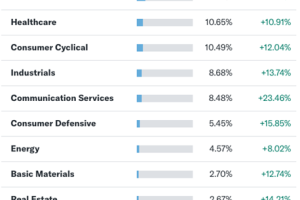Conflicting reports about oil demand in the coming decades … why you don’t have to make a binary wager … the link between fossil fuels and renewables … ways to play it
According to OPEC, oil demand is going to soar in the coming decades.
However, according to the International Energy Agency (IEA), oil demand is headed lower.
Now, it’s a bit obvious that OPEC would have a bias toward a bullish report. It’s a bit like a thermal underwear company conducting a study and concluding that temperatures are going to be really, really, really cold this coming winter!
But even factoring that in, the starkly different visions of the future outlined by these reports raises an eyebrow.
The OPEC study concludes that global oil demand will rise to 110 million barrels a day in about 20 years.
This is at odds with the IEA’s report that predicts a major slowdown in demand. Here’s CNBC with the IEA’s longer-term forecast:
Global oil demand growth will trickle nearly to a halt in the coming years and peak this decade, according to the International Energy Agency, with Chinese consumption set to slow down after an initial pent-up recovery.
“The shift to a clean energy economy is picking up pace, with a peak in global oil demand in sight before the end of this decade as electric vehicles, energy efficiency and other technologies advance,” IEA Executive Director Fatih Birol said in a statement.
Oil demand growth that “will trickle nearly to a halt” sounds a bit far-fetched. The very same IEA predicts oil demand in India, which may have just passed China as the world’s most populous nation, will grow 42% between 2021 and 2030.
Despite that point, we’re not going to make the case for, or against, oil in today’s Digest. OPEC’s own Secretary General, Haitham Al Ghais, summed up our take on it a few days ago:
Gas hydro, nuclear hydrogen and biomass will expand. But it is clear that oil remains an integral part of the mix.
To us, the more important question is “how do we make strong investment returns regardless of whether oil remains the world’s main energy source in the coming decades, or if renewables take center stage?”
One answer is we’d need to find companies that have exposure to profits from both fossil fuel energy and renewables – a “have your cake and eat it too” approach.
And this points us toward something you’re probably not expecting.
Lithium.
Get ready for the “great diversification” from the oil and gas majors
How in the world does lithium help investors get exposure to profits from both fossil fuels and green energy?
It’s a three-part answer.
Here’s Part I from Energy.gov:
A relatively rare element, lithium is a soft, light metal, found in rocks and subsurface fluids called brines. It is the major ingredient in the rechargeable batteries found in your phone, hybrid cars, electric bikes, and even large, grid-scale storage batteries.
As a “critical mineral” necessary for rechargeable electric batteries, lithium has been identified as a material essential to the economic or national security of the United States.
Here’s Part II from The White House:
As the world transitions to a clean energy economy, global demand for…lithium and graphite used in electric vehicle (EV) batteries…will increase by…as much as 4,000 percent.
And here’s Part III from Financial Times, which brings it all together:
Oil and gas majors are stepping up efforts to break into lithium to diversify beyond fossil fuels as hopes rise over a technological breakthrough to produce the metal critical for electric car batteries.
ExxonMobil, Schlumberger, Occidental Petroleum and Equinor are exploring whether their core skills of pumping, processing and reinjecting underground fluids such as oil and water could be deployed to process lithium from unconventional brine resources, helping to ease the forecast shortages of a material expected to be vital for the energy transition.
So, the bridge between fossil fuels and green energy is lithium. And the traditional oil/gas companies pursuing lithium exposure offer investors this two-pronged energy approach.
How do we invest in it?
Financial Times just offered four names of oil companies that are pursuing lithium exposure: ExxonMobil, Schlumberger, Occidental Petroleum, and Equinor.
But our macro expert and editor of Investment Report, Eric Fry, has suggested a fifth:
TotalEnergies SE (TTE).
Here’s Eric speaking directly to our energy goal of having our caking and eating it too:
[TTE] is a fashion-forward, energy-transition company. The company’s management understands both what has been and what will be – and they intend to maximize profit from both.
Specifically, management is pursuing a long-term strategy to reinvest the robust cash flows from Total’s legacy oil and gas operations into renewable energy projects and technologies.
Now, while we can infer that lithium plays a role this transition, it’s not directly obvious. Can we get greater verification?
Here’s PowerTechnology.com from earlier this spring:
TotalEnergies has announced the launch of its largest battery energy storage project in Europe…
TotalEnergies battery subsidiary Saft will supply 40 Intensium Max High Energy lithium-ion containers for the project, which is set to come online by the end of next year.
It appears “yes” – as Eric suggested, TotalEnergies is smack-dab in the middle of both fossil fuels and lithium-related renewables.
By the way, a big congrats to Eric’s Speculator subscribers who are up 112% in their TotalEnergies call option.
(And though not related to today’s topic, a second, even bigger congratulations for their 220% return on their Amazon calls that they closed out last Friday. To learn more about this elite trading service from Eric, click here.)
Now, you might be scratching your head, thinking “why don’t we just invest in lithium companies directly?”
Great idea!
After all, many of these oil and gas majors might decide to partner directly with a top-shelf lithium producer, or just take a major stake in one.
For example, back in 2021, Equinor became a partial owner of Lithium de France, and Occidental has a piece of TerraLithium.
So, which lithium company might you consider?
Well, regular Digest readers will recognize one name since we have an open trade on it…
Albemarle.
In late-April, we recommended Digest readers consider a trade in this world-class lithium company. You can re-read that Digest here , but in short, after Chile’s President Gabriel Boric announced his plans to nationalize the country’s lithium industry, ALB tanked 10%.
We noted this made no sense for a couple of reasons…
First, ALB management said the news will have “no material impact on our business” (it’s located in Charlotte, North Carolina).
Second, if anything, ALB should have climbed as it’s one of a few U.S.-based lithium companies, and as The New York Times recently reminded us, “the Biden administration…has allocated billions of dollars to encourage companies to develop lithium mines and refineries in the United States or in countries with which it shares close political and economic ties.”
In any case, the kneejerk 10% selloff resulted in massively oversold conditions in Albemarle’s stock according to its Relative Strength Index (RSI) level.
We saw the potential for short-term gains from a mean-reversion rally, combined with long-term gains from the same lithium growth story we’ve highlighted in today’s Digest.
So, what’s happened since?
Albemarle jumped out of the gate after our recommendation, and about one month later, it was up 20%.
We suggested that short-term traders could take some profits off the table because ALB’s RSI level had hit a peak and turned south. This suggested that some short-term weakness could be in the cards.
But for longer-term investors, we recommended no action. From that Digest:
However, if you jumped into ALB based on the overall lithium growth story, hang tight. We believe the long-term gains are just getting started, though they won’t be coming in a straight line.
As you can see below, things played out as we expected.
ALB did, in fact, pull back briefly, only to then continue climbing. The trade is up 30% since our recommendation.
We continue to believe there are more gains to come for the ALB trade as global demand for lithium intensifies.
Coming full circle to the start of today’s Digest, where will global oil demand be in two decades?
We don’t know. Fortunately, we don’t need to know.
There are wise investments you can make today that will help you generate strong returns regardless. You just need to focus on the energy companies that can generate healthy cash flows regardless of whether fossil fuels or renewables eventually rule the day – and/or focus on the leading lithium producers that will help energy companies straddle the fence.
Have a good evening,
Jeff Remsburg




